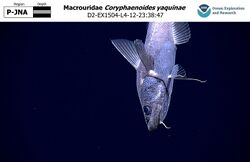Biology:Coryphaenoides yaquinae
| Coryphaenoides yaquinae | |
|---|---|

| |
| Front half specimen collected during a dive from the Okeanos Explorer in 2015 | |
| Scientific classification | |
| Domain: | Eukaryota |
| Kingdom: | Animalia |
| Phylum: | Chordata |
| Class: | Actinopterygii |
| Order: | Gadiformes |
| Family: | Macrouridae |
| Genus: | Coryphaenoides |
| Species: | C. yaquinae
|
| Binomial name | |
| Coryphaenoides yaquinae (Iwamoto & Stein, 1974)
| |
The rough abyssal grenadier (Coryphaenoides yaquinae) is a species of deep-sea grenadier fish in the family Macrouridae. First described as a separate species in 1974, the rough abyssal grenadier was historically confused with its congener, Coryphaenoides armatus.[1] Unlike C. armatus, which has been recorded in the waters of the Atlantic, Pacific, Indian, and Southern oceans, observations of C. yaquinae have been confined exclusively to the Pacific ocean.[2] C. yaquinae tends to inhabit abyssopelagic depths between 3,400 and 5,800 metres (11,200 and 19,000 ft)*.[1] However, observations of C. yaquinae have been made as deep as 7,000 metres (23,000 ft)* below sea level.[3]
Diet and ecology
The rough abyssal grenadier is an active benthic forager, with a diet that features a variety of seafloor fauna.[4][5] Squids, crustaceans, and polychaetes comprise the most consistent sources of prey for C. yaquinae, though stomach content analyses have revealed echinoderms, fish, and food scavenged from carrion.[5] The availability of these food sources varies, however, as seasonal migrations of pelagic teleosts and changes in the rate of phytodetritus affect the amount of organic matter that reaches the ocean floor.[6]
References
- ↑ 1.0 1.1 Endo, Hiromitsu; Okamura, Osamu (1992). "New records of the abyssal grenadiers Coryphaenoides armatus and C. yaquinae from the western North Pacific". ResearchGate 38 (4): 433–437. doi:10.1007/BF02905607. https://www.researchgate.net/publication/225135439.
- ↑ Jamieson, A.J.; Priede, I.G.; Craig, J. (June 2012). "Distinguishing between the abyssal macrourids Coryphaenoides yaquinae and C. armatus from in situ photography". Deep Sea Research Part I: Oceanographic Research Papers 64: 78–85. doi:10.1016/j.dsr.2012.02.001. Bibcode: 2012DSRI...64...78J.
- ↑ Jamieson, A. J.; Fujii, T.; Solan, M.; Matsumoto, A. K.; Bagley, P. M.; Priede, I. G. (2008-12-16). "Liparid and macrourid fishes of the hadal zone: in situ observations of activity and feeding behaviour". Proceedings of the Royal Society B: Biological Sciences 276 (1659): 1037–1045. doi:10.1098/rspb.2008.1670. PMID 19129104.
- ↑ Priede, I. G.; Bagley, P. M.; Armstrong, J. D.; Smith, K. L.; Merrett, N. R. (June 1991). "Direct measurement of active dispersal of food-falls by deep-sea demersal fishes". Nature 351 (6328): 647–649. doi:10.1038/351647a0. ISSN 1476-4687. Bibcode: 1991Natur.351..647P. https://www.nature.com/articles/351647a0.
- ↑ 5.0 5.1 Drazen, Jeffrey C.; Popp, Brian N.; Choy, C. Anela; Clemente, Tara; Forest, Lisa De; Smith, Kenneth L. (November 2008). "Bypassing the abyssal benthic food web: Macrourid diet in the eastern North Pacific inferred from stomach content and stable isotopes analyses". Limnology and Oceanography 53 (6): 2644–2654. doi:10.4319/lo.2008.53.6.2644. ISSN 0024-3590. Bibcode: 2008LimOc..53.2644D. https://aslopubs.onlinelibrary.wiley.com/doi/epdf/10.4319/lo.2008.53.6.2644.
- ↑ Armstrong, John D.; Priede, Imants George; Smith, Kenneth L. (September 1991). "Temporal Change in Foraging Behavior of the Fish Coryphaenoides-(Nematonurus)-Yaquinae in the Central North Pacific" (in en). Marine Ecology Progress Series 76 (2): 195–199. ISSN 0171-8630. https://abdn.elsevierpure.com/en/publications/temporal-change-in-foraging-behavior-of-the-fish-coryphaenoides-n.
Wikidata ☰ Q2921279 entry
 |

